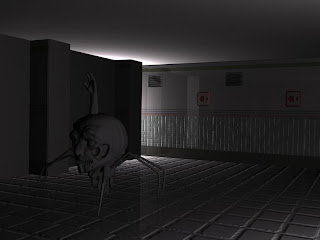 Due to the fact that the only standard bipeds that you can get on 3ds Max are all human shape for my none human shaped creature i had to make my own. The only part of my character that i needed to move for my cut scenes were the legs. The legs were all separate objects and weren't connected to each other or the head. Then i started making my own bones for each of the legs.
Due to the fact that the only standard bipeds that you can get on 3ds Max are all human shape for my none human shaped creature i had to make my own. The only part of my character that i needed to move for my cut scenes were the legs. The legs were all separate objects and weren't connected to each other or the head. Then i started making my own bones for each of the legs.The first thing that i had to do to make the bones was click on the animation drop down box and click on the bones tools... option. After i did this i had to click on the bone create button on the bones tool menu. after that i drew the three section of the leg with the bone tool and put the end result into the leg. When you draw a set of bones you can keep drawing them until you right click but when you do right click it will create a little square bone at the end that you just right clicked off. After i had drawn out the leg i clicked on the Animation drop down bar again but this time clicked on IK Solver and from that clicked on HI solver. With HI solver selected i clicked on the last square created with the right click and then the middle leg section. i then clicked on the connecting point between the second and third leg section and the leg section connecting the leg to the head. The reason that i did this is so that they would give me an easy moving point and because it i moved one limb it would move the limb that it is connected to through the HI solver giving it a more realistic effect. I repeated this on all six of the legs then i was ready for the animation first i did a quick test to see if the leg connectors worked properly which you can see below.
Then i did some research on spiders and how they moved before trying to properly animate the legs.
After i did this all i had to do was import merge my environment with this and move the characters to a different position so it looked like the character was actualy moving.




